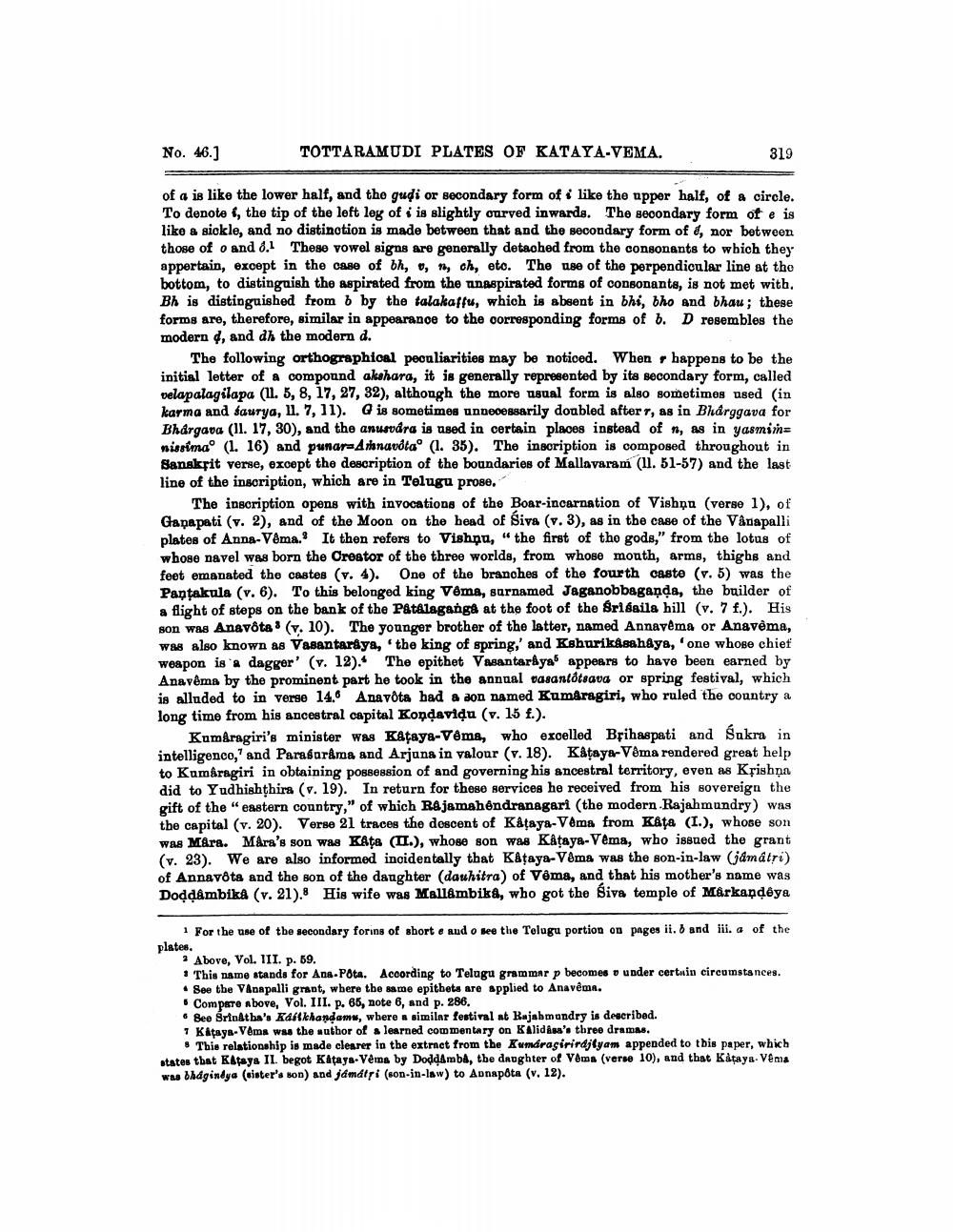________________
No. 46.]
TOTTARAMUDI PLATES OF KATAYA-VEMA.
319
of a is like the lower half, and the gudi or secondary form of like the upper half, of a circle. To denote, the tip of the left leg of i is slightly curved inwards. The secondary form of e is like a sickle, and no distinction is made between that and the secondary form of d, nor between those of o and 8.1 These vowel signs are generally detached from the consonants to which they appertain, except in the case of bh, 0, 1, ch, eto. The use of the perpendicular line at the bottom, to distinguish the aspirated from the anaspirated forms of consonants, is not met with Bh is distinguished from b by the talakaffu, which is absent in bhi, bho and bhau; these forms are, therefore, similar in appearance to the corresponding forms of b. D resembles the modern 4, and dh the modern d.
The following orthographical peonliarities may be noticed. When happens to be the initial letter of a componnd akahara, it is generally represented by its secondary form, called velapalagilapa (11. 5, 8, 17, 27, 32), althongh the more usual form is also sometimes used in karma and saurya, 11. 7, 11). G is sometimes unnecessarily doubled after 1, as in Bhdrggava for Bhargava (11. 17, 30), and the anusvára is used in certain places instead of ", as in yasmin= nissima' (1. 16) and punar-Arenavótao (1. 35). The inscription is composed throughout in Sanskrit verse, except the description of the boundaries of Mallavaram (1l. 51-57) and the last line of the inscription, which are in Telugu prose,
The inscription opens with invocations of the Boar-incarnation of Vishnu (verse 1), of Ganapati (v. 2), and of the Moon on the head of Siva (v. 3), as in the case of the Vanapalli plates of Anna-Véma. It then refers to Vishnu, “the first of the gods," from the lotus of whose navel was born the Creator of the three worlds, from whose mouth, arms, thighs and feet emanated the castes (v. 4). One of the branches of the fourth caste (v. 5) was the Panţakula (v. 6). To this belonged king Vêma, surnamed Jaganobbaganda, the builder of a flight of steps on the bank of the Patalagangå at the foot of the Srisaila hill (v. 7 f.). His son was Anavota" (v. 10). The younger brother of the latter, named Annavêma or Anavêma, was also known as Vasantariya, 'the king of spring,' and Kehurikásahaya, 'one whose chief weapon is '* dagger' (v. 12). The epithet Vasantar ya appears to have been earned by Anavêma by the prominent part he took in the annual vasantôtsava or spring festival, which is alluded to in verse 14.8 Anavõta had a son named Kumaragiri, who ruled the country a long time from his ancestral capital Kondavidu (v. 15 f.).
Kumaragiri's minister was Kataya-Vêma, who exoelled Brihaspati and Sukra in intelligenco," and Paraşarama and Arjuna in valour (v. 18). Kataya-Věma rendered great help to Kumkragiri in obtaining possession of and governing his ancestral territory, even as Křishạn did to Yudhishthira (v. 19). In return for these services he received from his sovereign the gift of the eastern country," of which Rajamahendranagari (the modern Rajahmundry) was the capital (v. 20). Verse 21 traces the descent of Kåtaya-Vema from Kåta (I.), whose son was Mara. Mara's son was Kåta (II.), whose son was Kåtaya-Vema, who issued the grant (v. 23). We are also informed incidentally that Kataya-Vêma was the son-in-law (jámátri) of Annavõta and the son of the daughter (dauhitra) of Vêma, and that his mother's name was Doddâmbika (v. 21). His wife was Mallámbika, who got the Siva temple of Markandeya
1 For the use of the secondary foring of short e aud o see the Telugu portion on pages ii. and ill. a of the plates.
? Above, Vol. III. p. 59. * This name stands for Ana-Pota. Acoording to Telugu grammar p becomes v under certain circumstances. • See the Vanapalli grant, where the same epitbets are applied to Anavêma. • Compete above, Vol. III. p. 65, note 6, and p. 286. • Bee Srinatha's Kahtkhandamw, where a similar festival at Rajahmundry is described. 1 Kataya-Vems was the author of learned commentary on Alidisa's three dramas.
# This relationship is made clearer in the extrnet from the Kumdragirirdilyam appended to this paper, which states that Kata ya IL begot Kataya.Vems by Doddamba, the daughter of Vema (verse 10), and that Kataya Vema was bhdgindya (winter's son) and jdmdtri (son-in-law) to Aunapota (v. 12).




